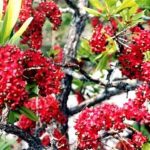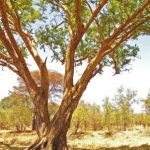TREE LIFE
November 1984
FORTHCOMING CALENDAR
Sunday November 18th : “New Erewhorn” Arcturus, the home of Mr. and Mrs. L. Henriques, well known to many of our Ayshire members. Behind the house in a delightful garden with refreshing green lawns, rises a kopje, perched on top of which is the most enormous spreading Acacia sieberana I have ever seen. In its shade and, no doubt, nitrogen enriched soil is a surprising community of trees including, we suspect a Psychotria sp. At the other end of the ridge Hymenodictyon was coming into flower. At the bottom of the hill was a big surprise, substantial trees of Phillipa – species still uncertain, of the family ERICACEAE – more at home on Inyangani. Most exciting. There are also flatter areas leading to a dam containing a pleasing variety. A total distance is only 29km from town so no bus has been booked. Instead, those wanting lifts and please, those able to offer lifts will meet at 0900 hours at the Monomatapa Car Park for departure at 0915 hours.
AYRSHIRE BRANCH
Sunday November 11th: AGM and outing to Tennessee Ranch. John Duffield has an interesting piece of territory for us to explore. We will meet for tea at Nkwodzi farm house at 1000 hours and then go tree hunting on Tennessee Ranch returning to Nkwodzi at mid-day. The AGM will be held in John and Anne’s Garden. Bring a picnic lunch, swimming togs, etc.
Gill Henderson also asked me to say that Harare people and from further afield would also be most welcome.
CHEGUTU CALENDAR
4TH November : Borden Farm on Mondoro Road, unless we have lots of rain which would make roads too sticky – so changes may be necessary.
BOTANIC GARDEN WALK OCTOBER 2ND 1984
According to Cronquist (1981) the subclass DILLENIIDAE hangs together as a natural group although it is difficult to characterize. In includes amongst others, the Sterculia, baobab, Hibiscus, Flacourtia, Salix, Erica, Euclea and the SAPOTACEAE. For this walk we examined the central order of the whole subclass, the Theales which has three indigenous families, the OCHNACEAE, DIPTEROCARPACEAE and CLUSIACEAE. In addition we looked at one of the other orders, the Capperales, represented by the CAPPERACEAE. Tom Muller agreed to show us these families although generally they are difficult to grow. Tom also warned against putting faith in presently accepted family relationships. Although most plant families were well established, the broader arrangements are still in a state of flux as more information is gathered. No classification system has yet stood the test of time. So, although Cronquist may be a great improvement on Engler and Prantl, it may not be absolute. The OCHNACEAE have alternate, mostly simple leaves with stipules and usually with numerous parallel lateral veins. This latter feature is most distinctive in all of our local species and is combined with an evenly toothed margin. Tom showed us Ochna arborea var oconnorii from the Eastern rain forests. On the edge of Mt. Chirinda forest these thin, smooth grey trunks stand out from the other trees as no lichens grow on them. The Ochna flowers are usually short lived but having seen Ochna pulchra in flower last month, we know they can be most attractive. At present the O. schweinfurthiana is in fruit in Mashonaland. The yellow petals fall early but the calyx enlarges and turns red. The strange fruit structure has separate carpels which swell up to form dark beads on the red sepals. The DIPTEROCARPACEAE is the meranti family. We generally recognize Monotes by its extra floral nectary at the base of the leaf. Many Asian genera need to have a fungal growth on the roots in order to grow well. These actotrophic mycorrhiza may be introduced by growing seedlings in soil from under adult trees.
In contrast to these two families the simple, entire leaves of the CLUSIACEAE are opposite. Two of the genera have a luminously coloured resinous juice in secretary canals of the leaf and petiole. In Garcinia the juice is yellow, whereas in Harungana it is orange. Generally this is an easy spot for this tree, although in the present drought a number of the ever green but very desiccated leaves of G. huillensis which we have found on the granite hills in Mashonaland have refused to display this feature without much perseverance. Tom showed us a small specimen of G. kingaensis, the Eastern forest species which grows amongst Syzygium and Bequaertiodendron. Near the car park we saw the whorled leaves of G. livingstonei. Tom’s trees demonstrated the distinct growth form and dark evergreen leaves which allows one to recognize this species from the car as one drives past riverine habitats. The tasty fruit apparently resembles that of the mangosteen which comes from the exotic G. mangostana.
Alongside the Raphia palms we saw a large specimen of Harungana madagascariensis a forest pioneer of the Honde Valley and Vumba area. It comes up in disturbed areas such as old fields and at roadsides where it is easily recognized by its brown, furry young leaflets which emerge as a pair of praying hands the fingertips gradually arching outwards. We often encounter the furry leaves of Psorospermum febrifugum on the outings. This is yet another CLUSIACEAE but without a colourful sap. When in doubt the row of black dots along the margin helps to confirm this species. The last CLUSIACEAE genus we saw is very different to these others. Hypericum also has the simple opposite decussate leaf arrangement. A hand lens shows the small pellucid glands in the leaf. To showed us the smaller leaves of H. revolutum, a forest pioneer found with Philipia lexandra in areas once disturbed by village clearing near Inyangani. The large leaved H. roeperanum is commonly found along streams in Manicaland. Both species flower profusely with large bright yellow blooms.
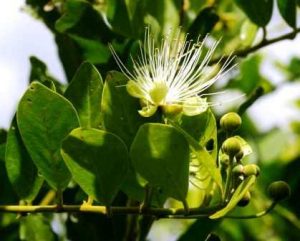
Capperis tomentosa. Photo: Bart Wursten. Source: Flora of Zimbabwe
Families of the order Capparales commonly produce mustard oils as a repellant to predators. With this protection they seldom produce the other chemicals like tannins alkaloids or iridoid compounds which also deter herbivores. We enjoy the biting flavor which these mustard oils have and eat many of the Capparales, including the radish, mustard cabbage, watercress and capers. But many predators have also overcome the toxic effects of mustard oils and prefer to feed on these plants. Herbarium beetles enjoy the mustard floured died lodged in these shelves. The common white and yellow butterflies of the family Pisridae home in on these oils to oviposit their eggs. As we noted on the walk looking at one of these families the CAPPARACEAE, the butterfly larvae may successfully defoliate these plants. This family used to be called the CAPPARIDACEAE but apparently CAPPARACEAE is more acceptable. Looking at Capparis tomentosa we noted the family’s alternate leaves. In this species they are simple and have a pair of hooked thorns on the stem which help it to climb into the canopy of anthill vegetation. Out of the mass of white stamens we saw the long gynophore, a projection with the swollen ovary near the end hanging right out of the flower itself. This strange structure is common in this family and should have helped us identify a shrubby Cadaba kirkii which stumped us in the Zambezi Valley recently.
Tom’s specimen of Ritches albersii was well eaten by caterpillars but the leaf skeletons demonstrated the palmate leaflets which we were to see again in this family. The leaflets are irregular in size with entire margins. Richea grows on trees with Craibia and Ficus sansibarica in the Eastern Highlands.
Avoiding the efficient watering system we saw Maerua caffra behind the Harungara. This Maerua grows as a tight bush on Murahwa’s Hill and is conspicuous when in flower. The digitate compound leaves each had from 3 to 5 leaflets and a furrowed petiole. The tips of each leaflet end in a small hair like tip yet another feature which occurs repeatedly in this family.
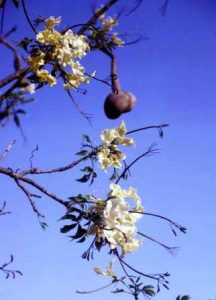
Cladostemon kirkii flowers. Photo: Darrel Plowes. Source: Flora of Zimbabwe
Tom’s Cladostemon kirkii is always spectacular this time of the year covered in yellow blossoms which have a most unusual structure, half of the stamens are fused and arch out of the flower five or six inches before branching. This androgynophore also bears the ovary which is stalked and branches off the structure near the end. Unfortunately these specimens have never fruited. The leaf if trifoliate. Alongside the Cladostemon is a small Cadaba termitaria, also in flower. This plant of the arid lowveld has simple leaves on condensed lateral spurs. The numerous red and green flowers were difficult to see amongst the branches.
The simple, entire leaf of Boscia has its own character, the texture tends to be hard and often with a spine tip on the end which is fairly aggressive in B. mossambicensis. In addition the mid vein is often pale and runs exposed along the underside like a guttering pipe. Tom showed us B. foetida. Two subspecies exist, subpp. rehmanniana lasting grey leaves is a shrub from Tuli Circle. The larger leafed suspp. foetida occurs in Gonarhrezoe and is common in Mozambique. Walking to the Combretum section we stopped at an anthill on which we found B. salicifolia with its long leaves, the scrambling Maerua juncea in flower, as well as a now dead M. angolensis, the bead bean.
We had not completed the family before darkness overtook the wanderings. We thank Tom for his time and interest.
-Kim ST.J.Damstra
KYLE FARM, BANKET OCTOBER 21ST 1984
This month we were very fortunate to be able to join the Aryshire Branch outing to Kyle Farm, Banket, the home of Ted and Anne Hatley. As it is so close to the Great Dyke we were able to see trees that we don’t usually come across on our outings close to Harare. After a cup of tea at the house we set off for some nearby kopjes where we somehow got split into two groups, one group taking in a visit to a cave whilst the rest of us dawdled a bit up the slope and over a ridge.
Near the bus was a tree with spiny yellow/green leaves which might have been Scolopia zeyheri or Maytenus undata but it has been confirmed by Mr. Drummond as Maytenus undata although it is an atypical example.
At the base of the kopje we saw Uapaca nitida which has smaller laves than Uapaca kirkiana, mahobohobo and long petioles It has the waxy look on the growing bud which is typical of Uapaca.
Next was Bridelia cathartica which did not have many leaves on it but had the characteristic old dead twigs with the remains of last year’s flowers still on them.
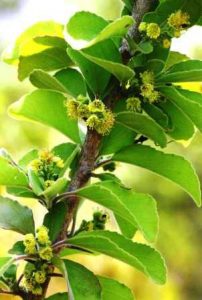
Flacourtia indica, Photo: Bart Wursten. Source: Flora of Zimbabwe
Nearby was Olax obtusifolia which had a few green fruits on it. Later we saw one with buds as well. We also saw Flacourtia indica, with its pink petioles and a vague scalloping on the edge of the leaves.
Throughout the morning Sterculia quinqueloba, which occurs at medium to low altitudes and is often a feature of rocky hills and slopes was very evident. The bark is smooth and the trees were coming into new leaf. The new leaves were covered with a sticky yellow substance as some of us learned to our cost. When they are full size they are large and 5 lobed as the specific name suggests.
A conspicuous feature of this area is Brachystegia boehmii also known as mufuti and Prince of wales’ feathers. We first noticed them when crossing the Dyke, many still with reddish coloured leaves. It is one of the four main trees which produce the characteristic coloured display of spring in Zimbabwe. Also present was Brachystegia glaucescens, another species which turns red in spring. It is confined to the summits and slopes of rocky hills and kopjes. These two species are similar but their differences were easily seen as they were growing close to each other. B. boehmii has bigger leaflets than B. glaucescens and rough bark. B. glaucescens has smooth bark which peels off the trunk.
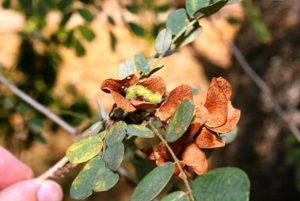
Ormocarpum kirkii. Photo: Mark Hyde. Source: Flora of Zimbabwe
Moving on we saw Ormocarpum kirkii. The flower does not drop but dries on the tree and if opened out the little pod, rather reminiscent of a worm, can be seen.
Close by was Ximenia caffra, the sour plum. This has spiny branches and furry leaves. We did not see it but X. americana also occurs in this country. It has blue/green leaves which are not furry as opposed to the yellow/green leaves of X. caffra. They can also be distinguished by their flower, X. americana having flowers in short sprays while those of X. caffra arise in tight clusters in the axils of the young leaves.
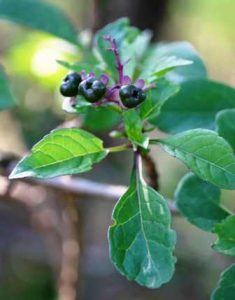
Clerodendrum wildii. Photo: Bart Wursten. Source: Flora of Zimbabwe
At this point we started climbing up the kopje where we saw Clerodendrum wildii. As it was just coming into leaf the leaves were very small but they still had that characteristic unpleasant smell when crushed. Close to it was Pterocarpus angolensis which we saw throughout the rest of the day. The buds were just beginning to open so we were able to see the yellow flowers and there were young green fruits as well as old ones.
Nearby was a tree showing the typical characteristics of the RUBIACEAE family, opposite leaves and interpetiolar stipules. It was a small specimen of Tarenna neurophylla which has rather long drooping petioles.
We then moved up onto a small ridge which consisted mostly of rock where we saw Azanza garckeana whose distinguishing feature is a gland, which looks rather like a bust pipe, on the midrib of the leaf.
There were two large specimens of Commiphora africana which does not have peeling bark, and Commiphora marlothii which has bark that peels away in very thin papery sheets to reveal the green trunk underneath.
Also present was Albizia tanganyicensis with its rough bark that peels away leaving a smooth trunk. The gland on the petiole typical of the genus Albizia, is so large on this species that it cannot be missed. There were ripe seed pods on it.
We also saw Kirkia acuminata, Lonchocarpus capassa, one of the rain trees, Pouzolzia hypoleuca, Vitex payos with its small white and purple flowers, Zanha africana and Tricalysia angolensis. As we descended the other side we saw Commiphora mollis, Stereospermum kunthianum, unfortunately it had finished flowering and Hexalobus monopetalus.
Diospyros kirkii was growing alongside the road on the way back to the bus. It has pink hairs on the new leaves and the fruit, which when ripe makes good eating has a large calyx. Albizia antunesiana, Syzygium guineense and Pseudolachnostylis maprouneifolia were also present.
Amongst the trees seen by the other group were Bequaertiodendron magalismontanum, Mundulea sericea in flower, seen last month at Barnhill Estate, Ochna puberula and Trichilia emetica.
After lunch in the cool garden we set off to cross the dyke over Caesar Mine Pass, stopping at a stream on the Pass to look at the trees there.
The first one we saw was Apodytes dimidiata with its pink petioles which seemed to be common to a lot of the other trees we saw during the afternoon. Later we saw A. dimidiata with its small, white star like flowers. Next was Rapanea melanophloeos which also has pink petioles and is commonly seen in the Eastern Highlands. Both these were growing under large specimens of Syzygium cordatum.
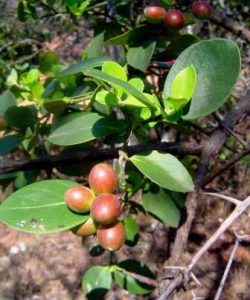
Carissa edulis. Photo: Bart Wursten. Source: Flora of Zimbabwe
Growing along the stream were large numbers of Phoenix reclinata, a palm often grown in gardens. Also common was Carissa edulis which was flowering. It has white flowers tinged with pink and sweetly scented. Growing nearby were Nuxia oppositifolia which has small, white flowers and opposite leaves, Euclea crispa and E. divinorum.
Walking upstream we saw Ilex mitis which is in the same genus as the European holly Ilex aquifolium. It has purple petioles and leaves which look chlorotic, which means they are light green/yellowish in colour and rather patchy looking as if the plant is lacking in nitrogen. The leaves are usually entire but sometimes if you look carefully you will see some that are notched.
Next was Maesa lanceolata with flowers and fruit and Bequaertiodendron magalismontanum with flowers on the stem.
Before crossing the stream we saw Ozoroa longipetiolata which is confined to the Great Dyke. As the name indicates, it has long petioles.
On the other side of the stream were Securidaca longipedunculata in bud and with last years winged seeds still on it, Osyris lanceolata with its small green flowers and Schrebera alata, the wing leaved wooden pear.
We all piled back into the bus at four o’clock and continued up the Pass but as it got steeper it soon became clear that the bus was not going to make it and that we had better turn back. It was decided to return to Harare by the Mutoroshanga Pass which we crossed without mishap only to break down by the Mwenje River. However we were able to enjoy sitting out in the cool evening air and it was not long before a new bus arrived from Harare. Our thanks to the Hatleys for having us for the day, to Mrs. Elise Torrie who let us use her telephone and who came to our rescue by bringing us a supply of soft drinks, orange juice and water, to Mrs. Castello who kindly stopped and offered a lift home for three people. This was a great aid as Gill Masterson was able to phone a number of relatives and ease their minds. We must also thank the bus company for sending a rescue bus so promptly.
-Barbara Browning
CHEGUTU BRANCH NOTES
On 7th October Chegutu Branch held a well attended outing at Stockdale Farm home of Mr. and Mrs. Richard Etheridge. The farmhouse is set on a bend of the Umfuli River with attractive views of unspoilt riverine vegetation, and it was gratifying to see that our hosts have planted several indigenous trees in their garden to compliment a large Mimusops zeyheri and a Sercuridaca longepedunculata, about to flower, growing on the bank.
Our first walk took us parallel to the river where there were groves of Acacia polyacantha which gave way to Cassia singueana in fruit, C. abbreviata in flower, Bolusanthus speciosus in bud, Acacia amythethophylla in new leaf, and Combretum fragrans dripping with fresh young fruit. We then cut through to the river bank seeing Colophospermum mopane which had been cut down perhaps thirty years ago and had coppiced to grow again into trees of a respectable size. In this area were also Balanites aegyptiaca, Capparis tomentosa in flower and, I thought, Commiphora marlothii, no leaves.
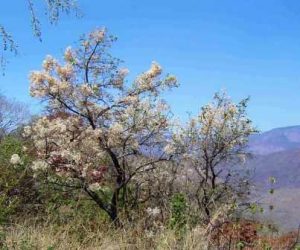
Dombeya rotundifolia. Photo: Bart Wursten. Source: Flora of Zimbabwe
The river bank was thick with trees, Diospyros mespiliformis, D. kirkii, D. ycioides, Kigelia africana with young sausages, Dombeya rotundifolia, a tall specimen with just fading flowers; Kirkia acuminata, more usually seen on the skyline of kopjes, Rhus quartiniana and Pterocarpus rotundifolius, Strychnos potatorum, Azanza garckeana, Berchemia discolor, Albizia amara, amongst others. A large Croton megalobotrys and the biggest Croton gratissimus we have seen were of special interest, not really looking even faintly related.
After lunch a video on the subject of baobabs was shown to us and it was most interesting to see the varied life forms which these trees can support.
Richard then took those of us remaining to a nearby kopje where an ancient stone fort is situated. This afforded fine views of the surrounding countryside and although, sadly the illegal woodcutters from Chegutu had been at work on the site we were able to see, in dry contrast to the riverbank vegetation, Elephantorrhiza goetzei flowering Ozoroa insignis in tiny new leaf Cassine matabelica in leaf Cussonia arborea, leafless, plenty of small Pleurostylia africana, Acacia goetzei and Lannea discolor and several very tall Faurea saligna.
To elude the oncoming rain we returned to the farmhouse to thank our hosts for a very agreeable day.
-C.F.D.W.
LETTER TO THE EDITOR :
Having just returned from a visit to South Africa, I thought it might interest you and the members of the Society that on one farm I visited, owned by Mr. R. Nel in Vryheid area, we found an Erythrina tree with large pink flowers. The tree looks like an Erythrina abyssinica or latissima as far as the leaves are concerned, being furry and the bark corky. I have read Trees of Southern Africa and found no mention of pink flowered Erythrina. It is most definitely a wild or indigenous tree. I know there is also a cultivated garden species with pink flowers due to the soils or the environment. I must say one does become excited when confronted with a tree that one has never seen before. Unfortunately I could not collect specimens. I would like to know what species it is.
Andy Williams, Box 51, Gweru.
MATABELELAND CALENDAR AND NOTES
Sunday November 4th : Meet at Junction of Circular Drive and Old Gwanda Road, 0830 hours.
For our October meeting we went to Hillside Dams hoping to find enough leaf for identification. Fortunately some leaves were out but some difficulties and confusions did occur as in many cases the leaf was very new and small. Also one forgets that with the close growth of many trees in this area often gives a forest canopy effect, and places much leaf out of reach.
Despite some confusions we identified nearly 50 trees in under three hours, including Acacia galpinii, A. gerrardii, A. karroo, A. nilotica, A. rehmanniana and A. sieberana; Acokanthera rotundata (schimperi), Azanza garckeana, Berchemia zeyheri, Canthium lactescens, Cassine matabelica and C. transvaalensis, Catha edulis, Celtis Africana, Combretum molle, Commiphora mollis and C. schimperi, Cussonia natalensis, Ehretia rigida, Euclea divinorum and E. natalensis, Euphorbia ingens, Erythrina latissima Ficus ingens and F. natalensis, Lannea schweinfurthii, Maytenus heterophylla, M. senegalensis and M. undata, Olea europeae subsp. africana, Pappea capensis, Pouzolzia hypoleuca, Pterocarpus rotundifolius, Pterolobium stellatum, this when leafless very like Fagara, now Zanthoxylum, Rhus lancea and R. leptodictya .
You asked about Acacia chariessa. It is of course a shrub, but as an Acacia a family friend. Drummond numbered it 194 in his list of Tree, Shrubs etc., separate from Kirkia Vol. 10. 1975. Being a shrub it does not occur in the later Tree List. It occurs in the WCS areas, and of course here and there round Bulawayo. Stedman also calls it “a graceful low growing bush”. The stems and thorns are markedly reddish. This is really the best identification feature. The thorns are scattered, Pinnae 6 or 7, leaflets small. The flower is yellowish-white spikes, usually November to March, fruits clusters of flat red pods, conspicuous. I have usually seen it relatively isolated, but I understand that groups and even thickets occur.
-C.Sykes,
-PHILIP HAXEN CHAIRMAN


